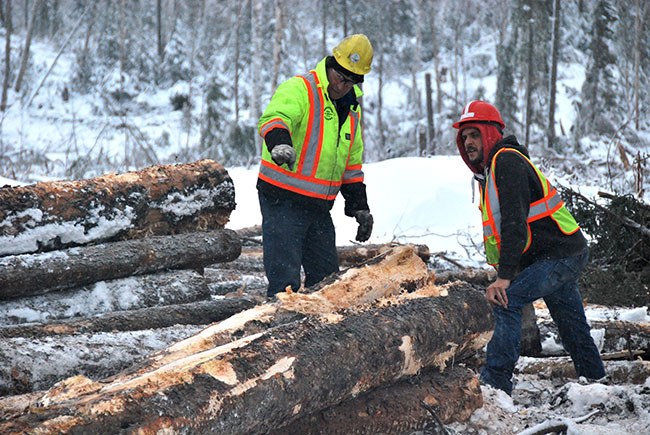
Features
Succession for your business
Taking the right steps ahead of time will pay off
January 4, 2024 By Chris Duncan
 All business owners should be working on their succession plan despite how old they are.
All business owners should be working on their succession plan despite how old they are. A logger never truly retires.
Whether they continue running a buncher or advise the next generation about big business decisions from a sunny destination instead of in the pickup truck, there is rarely a time when a logger can fully step away from the business that they’ve spent their lives building.
According to results of CFI’s 2020 Contractor Survey, 36 per cent of contractors do not have a succession plan.
Not having a plan is the equivalent of driving a loaded logging truck down a hill without brakes and blind folded, you have no way to tell when to apply the brakes or turn the steering wheel.
Much like driving, many different issues can come up that change a contractor’s plans on when to get out or slow down with their business.
All business owners should be working on their succession plan despite how old they are. You and your family are the priority in a succession planning process. Managing your legacy while you can gives you the peace of mind, the clarity, and the ability to ensure your wishes are fulfilled.
The process
Once you’ve decided you’re ready for a change, the right planning allows you to work at your own pace with an advisor to determine how best to approach the process.
It’s important to note that business transition planning is a continuum.
While it’s easy to plan for a start point, it’s common for an event to cause the trajectory to change – whether that’s an illness or death in the family, or someone wanting to get out of the business – forcing a reassessment of goals and strategies to meet them.
Your plan should be constantly evolving based on what is happening in life.
While every process will be unique, here are some things your advisor should help you with on your succession journey:
- Regardless of your initial goals, every plan starts with an initial info gathering meeting. This could be a single meeting or a series of meetings depending on your business and the complexities involved. By getting to know you and your family situation, your advisor can get a better understanding of your wishes, expectations, and the opportunities available to you all. Many business owners choose to involve family members in one or more of the meetings.
- In some cases, business meetings and family meetings will be separate to help detach the two in a meaningful way. This can help preserve family harmony, setting aside time to be a family and other time to be business owners.
- Succession planning doesn’t just go over with what will happen to the business, it also works to build a wealth plan, a business plan, strategic plans (depending on timing), and contingency plans.
- Setting up milestones, or graduation dates, is another important part of the planning process. It’s helpful to ask what you want to have accomplished by a certain time to help set achievable and measurable goals and keep everyone on track towards your shared vision.
- Assessing things like governance and tax reorganization may seem like one of the more daunting aspects of transition planning but really, it can be made simple with your advisor’s help and knowledge of the industry. Additionally, tax incentives and breaks can help you plan and take advantage of government opportunities when you have the chance.
- Asking questions about shareholder or family agreements – whether they’re needed and how they could help the process – provide more insight into family roles within the business and for the ownership of the business.

Succession planning for your forestry business won’t happen overnight, but taking the right steps ahead of time will pay off.
Examples of successful succession planning
In hypothetical scenario No. 1, two non-related business partners begin succession planning in their early fifties. While not prepared to exit yet, they start to plan on how they can maximize the tax savings and sale price of their business.
The partners work with an advisor to restructure their business for tax purposes. This included moving land and buildings out of their operating company and into a holding company and forming family trusts.
They also work with the advisor to maximize profitability and grow the enterprise value of their business.
Fast forward to their late fifties and one partner wants to retire. They have grown the company’s value and decide to sell with the help of the advisor.
After a successful sale of the business shares the partners keep the land and building and rent it back to the new owner.
In addition, with the restructuring they did a decade earlier, they can sell the shares and utilize their lifetime capital gains exemptions to minimize tax on the sale.
They now have the sale proceeds to retire and enjoy life, as well as a steady rental income stream. A decade of planning paid off greatly in this case.
In hypothetical scenario No. 2, a family contracting business run by mom and dad has four sons. Two sons are currently involved in the business, but the rest are not.
Mom and dad want to step back as dad’s health is waning. They engage with an advisor and the family begins to have family and business conversations with their advisor to determine what they want, who wants what level of involvement, and how that might progress.
During a meeting, it’s expressed that mom and dad want to keep involved in the business but on a limited basis. They decide to relinquish management duties, but still be available for access if they are needed. The two active sons agree on their roles within the business and the two others remain focused on other plans outside the business.
Mom and dad still have preferred voting shares in the business and have been able to access their lifetimes capital gains exemptions by selling a portion of their shares to their two active sons.
Within 18 months from the start of the process, they had a firm plan, and all parties are pleased with the flexibility and confidence they have in the future of the business.
Just as every logging business is unique, so too will be their succession plan.
Be patient with yourself and your family and understand success isn’t immediate nor is it guaranteed, it’s a process and a continuum that takes time, reflection, and forward thinking.
Two similar loggers who harvest 150,000 cubic meters a year and have $10 million in equipment will have completely different goals and strategies when it comes to succession and their outcomes will be different.
Expectations, health situations, financial and economic situations may change but your vision of your business and how it can support you in the future must be front of mind.
It’s never too early to start the process as a logging business owner. Even if you’re young and succession is decades away for you, taking the time now to consider what you want your future, and the future of your family, to look like will help ensure you’ve done a thorough job of planning and making choices to reflect and hopefully help you attain your goals.
Chris Duncan, CPA, is a partner and the national leader of forestry and forest products services at MNP. Chris has deep industry experience delivering business advice to logging contractors, value-added wood processors and other forest industry-related businesses.
Print this page